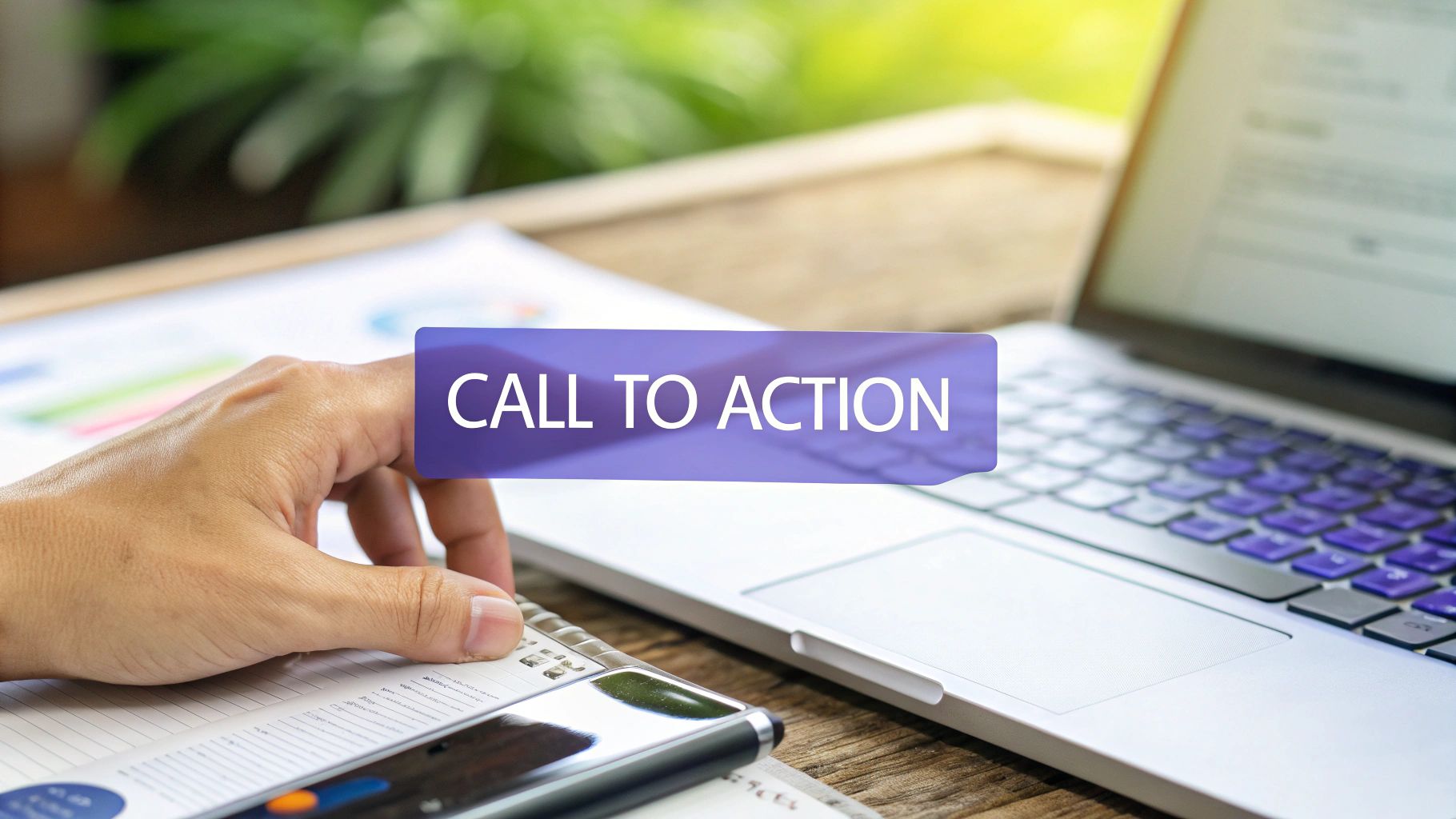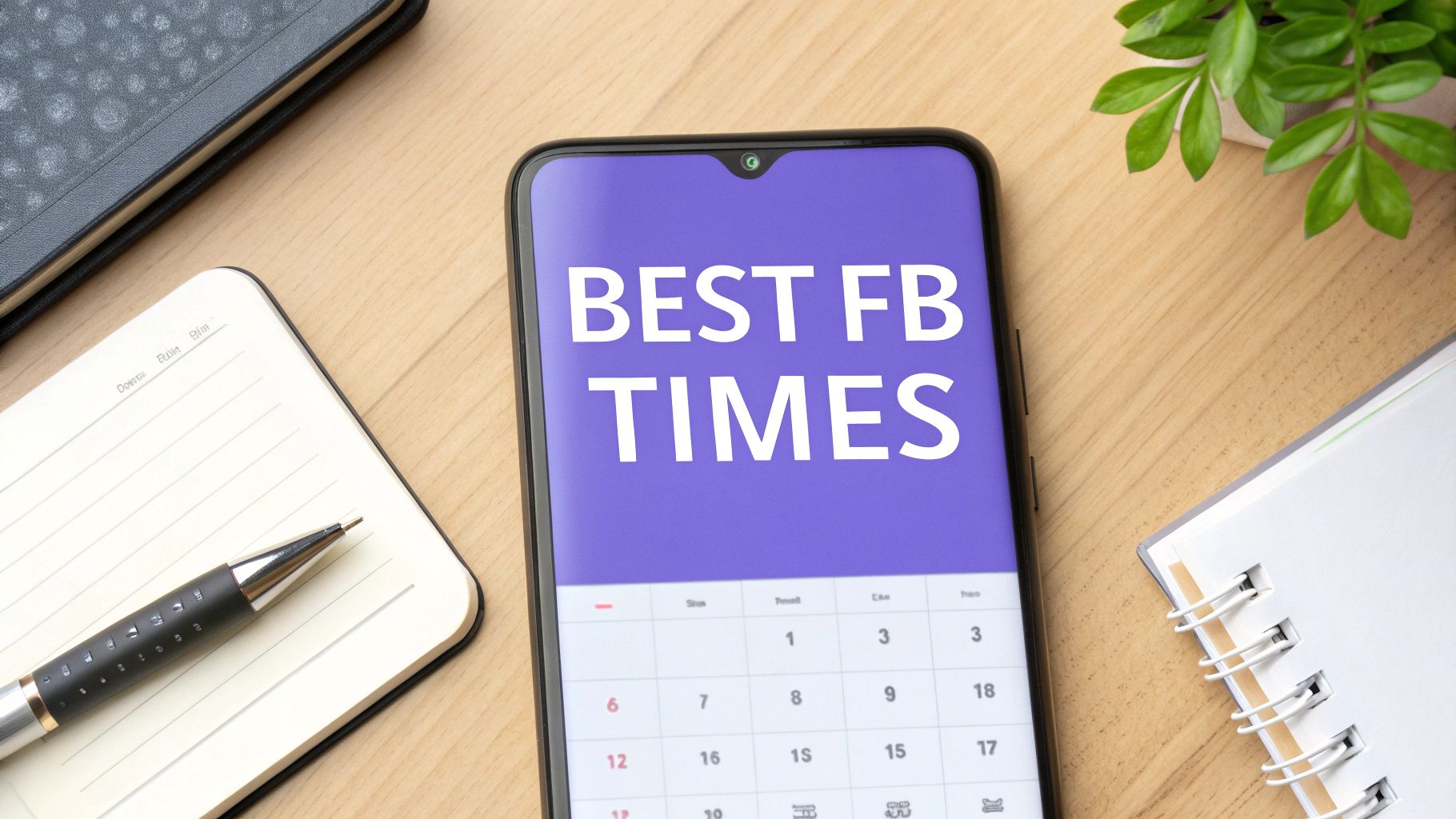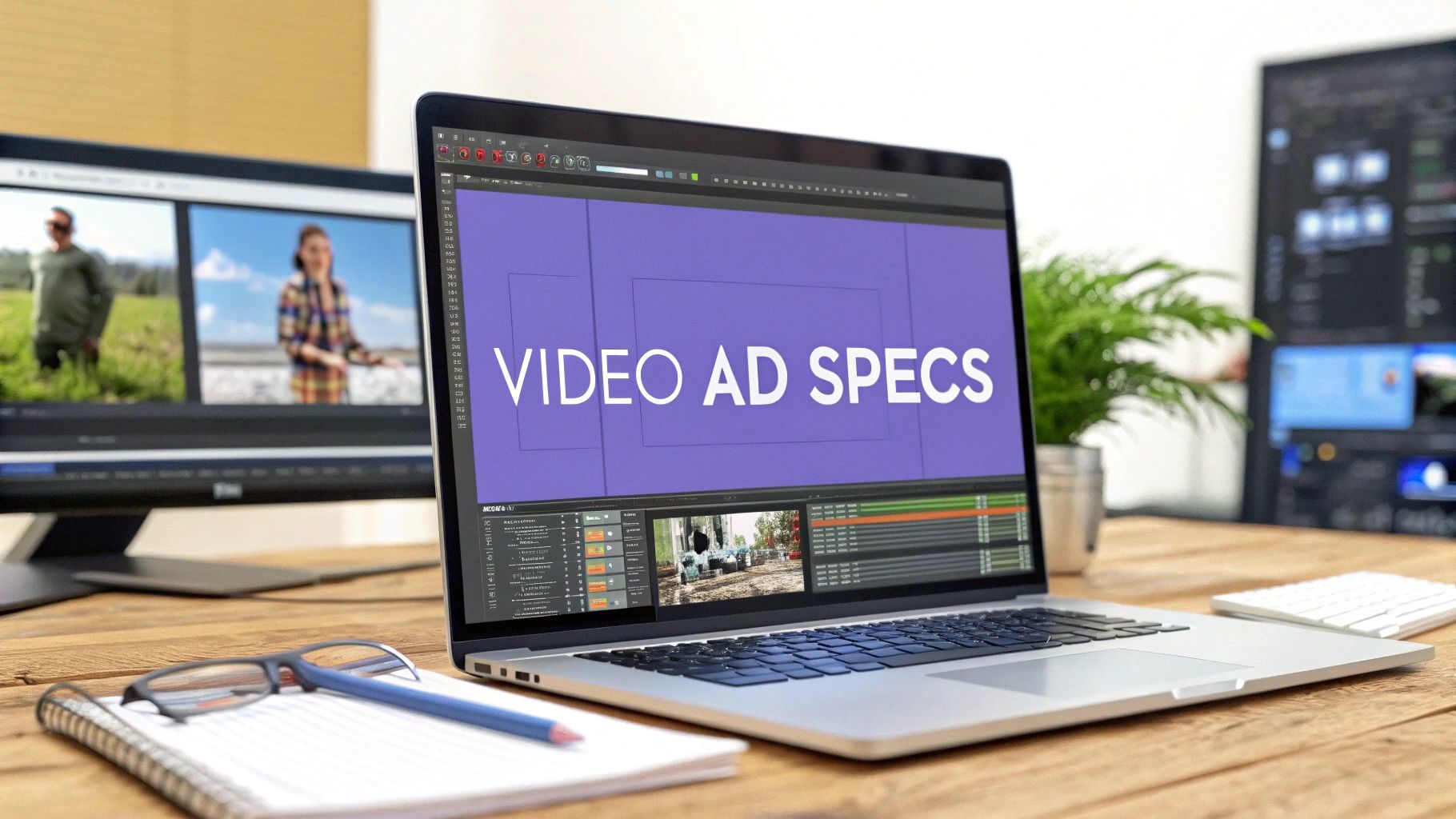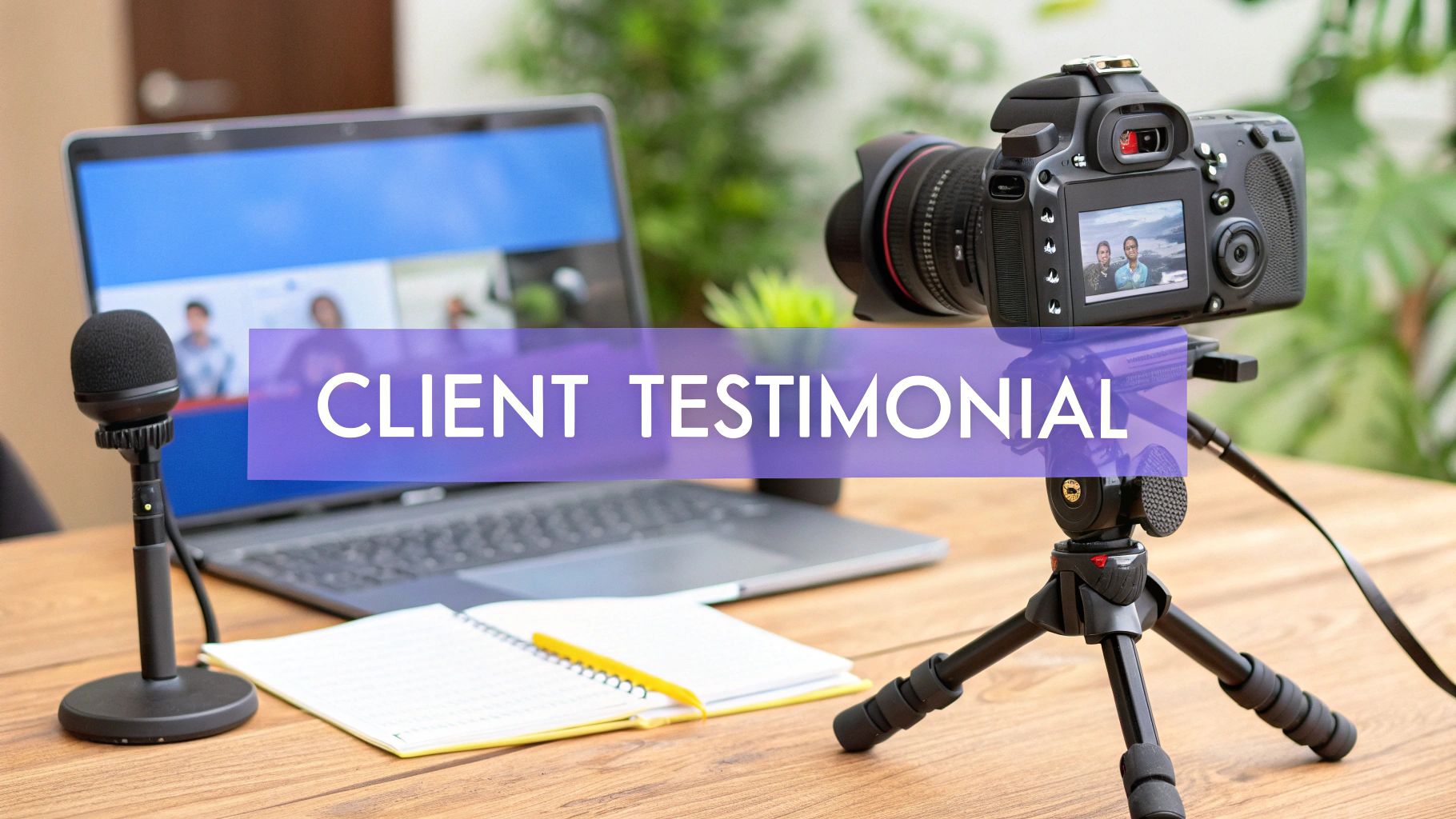Ever been on a website and felt a little lost? You read some interesting information, but then... what? You're left wondering what to do next. That's a classic case of a missing call to action, or CTA.
A CTA is simply a prompt that tells someone what you want them to do. It’s the bridge between them just looking at your content and actually taking a step forward with your brand. Think of it as the friendly voice that says, "Hey, this way!" It could be a button, a line of text, or a spoken phrase in a video.
Decoding Your First Call to Action
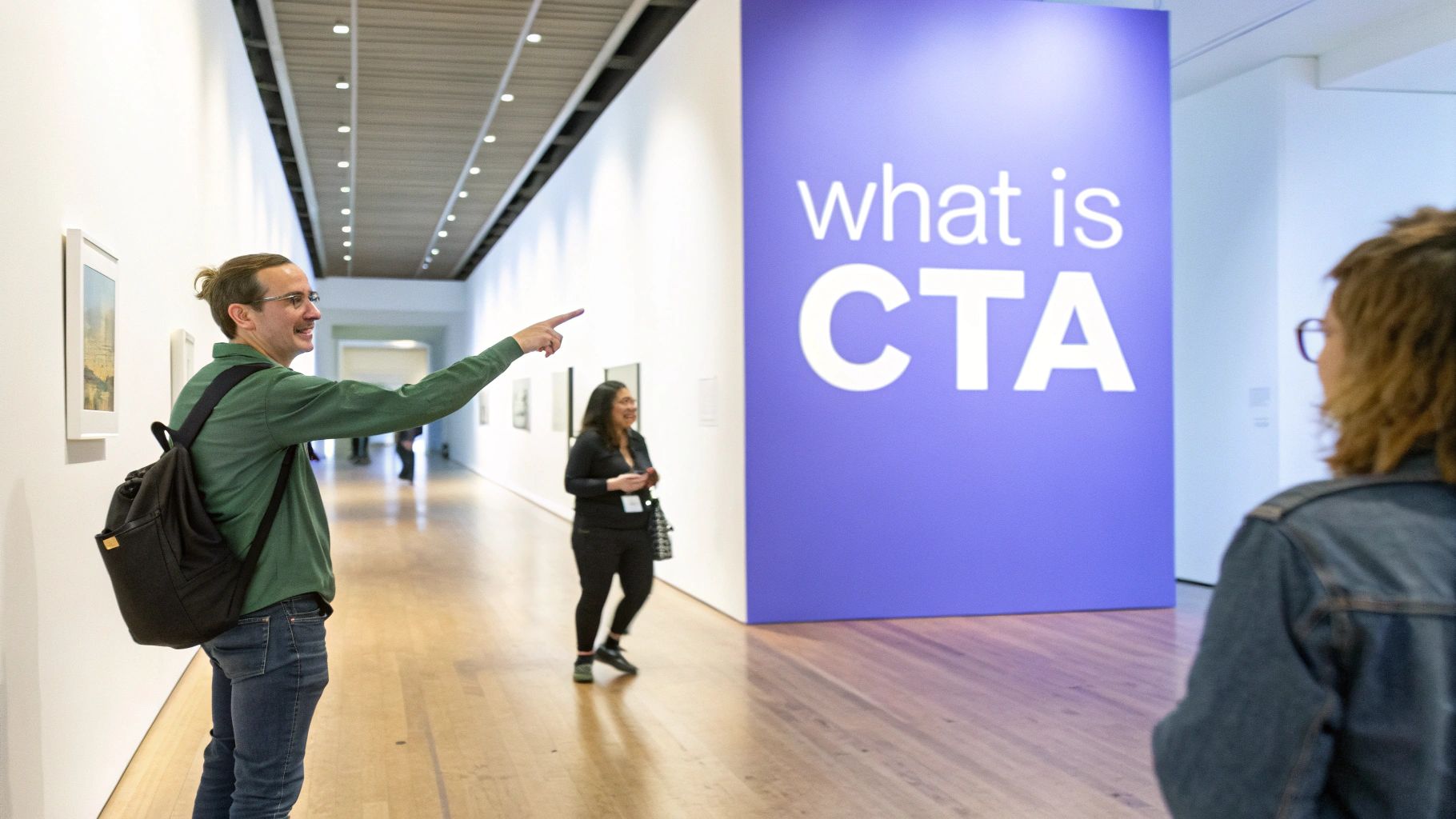
Let's say you’ve just poured your heart into a killer video ad. The story is compelling, the visuals are sharp, and your message is spot-on. The video ends... and crickets. If you don't give your viewers a clear next step, they’ll just keep scrolling. That’s why figuring out what is a call to action is so critical to your success.
A good CTA gives your audience direction. It takes them from being a passive viewer to an active participant in a single click. Without it, you’re just hoping they figure it out on their own—and hope isn't a strategy.
The Purpose Of a Clear Cta
At its core, a call to action is about removing confusion. It answers the silent question every user has: “Okay, what now?” By giving them a simple, compelling answer, you make it incredibly easy for them to stay engaged.
A really effective CTA is built from a few key ingredients. It’s not just a random command; it’s a thoughtful invitation that aligns with what the user wants.
A well-crafted CTA is more than just a button; it's a conversation starter that guides your audience from passive interest to active engagement, transforming potential into measurable results.
If you want to dig deeper into the psychology and mechanics, there are some great resources on what makes a good Call to Action. This clarity is the engine that drives your marketing forward.
To really get it, let's break down the individual parts that make a CTA work.
Core Elements of a Call to Action
| Component | Role | Example |
|---|---|---|
| Action Verb | This is the command. It tells the user exactly what to do. | "Download" the guide |
| The "What" | Explains what the user gets by taking action. | Download "the free e-book" |
| Urgency/Scarcity | Creates a reason to act now instead of later. | Get it "before it's gone!" |
| Visual Cue | The button, link, or graphic that draws the eye. | A bright orange "Shop Now" button |
Putting these pieces together is how you turn a simple instruction into a powerful conversion tool.
Key Benefits Of Using Ctas
Every single piece of marketing you create—from a blog post to a billboard—gets better with a strong CTA. Here’s a quick rundown of why they are absolute non-negotiables:
- Boosts Conversion Rates: You can't get what you don't ask for. A direct prompt like "Get Your Free Trial" or "Shop Now" drastically increases the odds of someone taking that next step.
- Improves User Experience: Good CTAs are like signposts. They guide people through your sales funnel smoothly, making the whole process feel natural and intuitive.
- Provides Measurable Insights: When you track how many people click your CTAs, you get hard data. This tells you exactly which offers and messages are hitting the mark with your audience, so you can do more of what works.
Why a Call to Action Is Your Marketing MVP
Picture this: you've just cooked an amazing dinner, set the table, lit the candles… and then you forget to actually tell anyone to sit down and eat. All that work, for nothing. That's exactly what a marketing campaign without a call to action (CTA) feels like. You're putting great stuff out there, but you’re not telling people what to do with it.
A CTA is what pushes your marketing strategy forward. It’s the simple, direct instruction that turns someone just looking into someone who’s actually doing something. Without that little nudge, your audience is left standing at a fork in the road, confused. And what do confused people usually do? They leave.
Turning "That's Interesting" into "I'm In"
Every blog post, video, or social update you create needs a goal. Maybe you want more leads, a direct sale, or just a more lively online community. The CTA is what makes that goal crystal clear to your audience. It’s a bright, flashing sign showing them the next step.
Let's say someone lands on your blog and loves your article about the latest industry trends. Great! But without a CTA, they'll read it, think "that was neat," and click away. But what if you add a simple prompt like, "Download our free trend report"? Suddenly, you've given them a concrete action to take. You've turned their passive interest into a real, measurable step.
A call to action is the bridge between your audience just consuming content and actively converting. It cuts through the noise and shows them the next logical step to take with your brand.
By giving them that clear direction, you’re also fighting off decision fatigue. People are bombarded with information all day long. A strong CTA makes their life easier by making the choice simple and obvious. It helps them say "yes" without having to overthink it.
Paving the Path to Conversion
At the end of the day, marketing success is measured in conversions. A CTA is the final piece of the puzzle that makes those conversions happen. It’s the button they click, the form they fill out, and the number they call. Each little action moves a potential customer closer to becoming an actual customer.
Here’s how CTAs carve out that path:
- For Lead Generation: They're your go-to for gathering contact info. Offer a valuable e-book or webinar in exchange for an email. You can see more tactics like this in our guide to small business lead generation.
- For Sales: They close the deal. Phrases like "Buy Now" or "Add to Cart" take a prospect from just browsing to making a purchase.
- For Engagement: They build your community. Simple asks like "Leave a Comment" or "Share This Post" invite people to become part of the conversation.
Without these prompts, your marketing is just a library of information. With them, your content becomes a dynamic tool that builds your business, one click at a time. A CTA isn't just a friendly suggestion—it’s the engine of your growth.
CTA Types for Every Marketing Goal
A call to action isn't a one-size-fits-all solution. Think of it like a carpenter's toolbox—you wouldn't use a sledgehammer to drive a nail. In the same way, you need different CTAs for different marketing goals. The secret is matching your prompt to your objective to turn a passive browser into an active customer, whether you want them to subscribe, buy, or just share your stuff.
The best CTAs meet people exactly where they are. A first-time visitor to your blog probably isn't ready to see a "Buy Now" button. That's too much, too soon. But offering a "Download Our Free Guide"? That feels like a natural, helpful next step. This kind of strategic thinking makes your marketing feel less like a pushy sales pitch and more like a friendly conversation.
Lead Generation CTAs
The main job here is simple: get a visitor's contact information. You're turning an anonymous lurker into a genuine lead you can talk to later. These CTAs work by offering a fair trade—something valuable in exchange for an email address or phone number.
Here are a few classic examples:
- Download Our Free eBook: This is a great way to share deep knowledge and show you’re an expert in your field.
- Get Your Custom Quote: A perfect fit for service businesses, this gives potential clients a personalized reason to connect.
- Subscribe to Our Newsletter: This is how you stay on their radar, sending regular updates and content right to their inbox.
A lead generation CTA is really just a digital handshake. It’s the moment a casual visitor raises their hand and says, "I'm interested, tell me more," opening the door to a real relationship.
If you’re running paid ads, this is where the magic happens. Getting good at platform-specific tools is a must. For example, mastering Google Ads lead form extensions lets you capture lead info right inside the ad itself, which is incredibly powerful.
Sales and Conversion CTAs
Okay, now it's time to close the deal. When someone is ready to pull out their wallet, your CTA has to be direct, confident, and free of any confusion. The goal is to make buying from you as easy as possible. You'll see these everywhere, from product pages to the bottom of sales emails.
Good sales CTAs are all about action and creating a little bit of urgency.
- Add to Cart: The undisputed king of e-commerce CTAs. Everyone knows what this means.
- Buy Now: This is a more direct path to checkout, ideal for someone who has already made up their mind.
- Get Started Today: This is a slightly softer approach that works well for subscriptions, software trials, or service sign-ups.
These prompts pack the most punch when the customer has all the info they need and is right on the edge of a decision. Stick them right after your product descriptions, pricing tables, or glowing customer testimonials to seal the deal.
Engagement and Community Building CTAs
Not every CTA has to be about making a sale or grabbing a lead. Sometimes, the goal is just to build a tribe of loyal fans who love what you do. These CTAs are all about fostering a sense of community and getting your audience to interact with your brand on a more human level.
These are typically low-effort requests that are easy for someone to act on.
- Leave a Comment Below: An open invitation for people to share their thoughts and get a conversation going.
- Share This Post: This turns your audience into your marketing team, helping spread your content to their own networks.
- Follow Us on [Social Media Platform]: A simple ask that grows your social media presence and keeps people plugged into your daily content.
By focusing on engagement, you're playing the long game. You're building brand loyalty that pays off down the road and creating advocates who will happily tell others about your business.
Choosing the Right Call to Action for Your Goal
Picking the perfect CTA can feel overwhelming, but it gets a lot easier when you match the prompt to your goal. This table breaks down which CTA to use based on what you want to achieve, giving you some go-to phrases and the best spots to place them.
| CTA Type | Primary Goal | Example Phrasing | Best Placement |
|---|---|---|---|
| Lead Generation | Capture contact info | "Download Free Guide," "Get a Quote," "Join Our Waitlist" | Pop-ups, landing pages, ad extensions |
| Sales & Conversion | Drive immediate purchase | "Buy Now," "Add to Cart," "Get Started Today" | Product pages, pricing tables, sales emails |
| Engagement | Build community | "Leave a Comment," "Share This," "Follow Us" | Blog posts, social media, video descriptions |
| Event Promotion | Increase attendance | "Register Now," "Save Your Seat," "RSVP" | Event pages, email invites, social ads |
| Discovery | Encourage exploration | "Learn More," "See Our Work," "Explore Features" | Homepages, feature sections, introductory content |
Use this as a quick reference guide. When you align your CTA with both your business objective and your customer's mindset, you create a clear path for them to follow, making it a win-win for everyone.
Craft CTAs That Actually Convert
Alright, so you know what a CTA is. But how do you create one that actually gets people to click? It's more than just slapping a button on a page. The best CTAs are a smart mix of persuasive words, eye-catching design, and a little bit of psychology.
Honestly, tiny tweaks to these elements can make a massive difference in your results. Getting someone to go from a passive browser to an active customer often boils down to that final nudge. Your CTA has to be clear, show them what's in it for them, and be almost impossible to ignore.
Start with Strong, Action-Oriented Language
The words you choose are the engine of your CTA. Generic phrases like "Click Here" or "Submit" are fine, but they're boring. They don't inspire anyone. To really drive action, you need strong, commanding verbs that tell the user exactly what to do and what they’ll get.
Think about the value you're offering. Instead of just giving a command, frame the action around the benefit.
- Instead of "Download," try "Get Your Free Guide." It feels like they're gaining something tangible.
- Instead of "Subscribe," use "Join Our Community." This sounds inclusive and collaborative, not like a one-way street.
- Instead of "Buy," consider "Claim Your Discount." This creates a sense of immediate reward.
The goal is to make the click feel like the next logical step toward something they want, not just a task to check off a list.
Inject Urgency and Scarcity
Let's talk about one of the most powerful motivators out there: the fear of missing out (FOMO). People are far more likely to act now if they think an opportunity is about to disappear. Adding a little urgency or scarcity gives them a real reason not to put it off until later.
You don't have to be pushy about it. Even a subtle nudge can be enough to get someone off the fence.
A sense of urgency is what turns a "maybe later" into a "yes, now." It's the catalyst that flips the switch from consideration to conversion by showing someone what they stand to lose.
Here are a few simple ways to do this:
- Use time-sensitive language like "Limited-Time Offer" or "Deal Ends Today."
- Highlight scarcity with phrases like "Only 3 Spots Left!"
- Add a countdown timer to your landing page or email.
This infographic shows just how much tactics like urgency can move the needle.
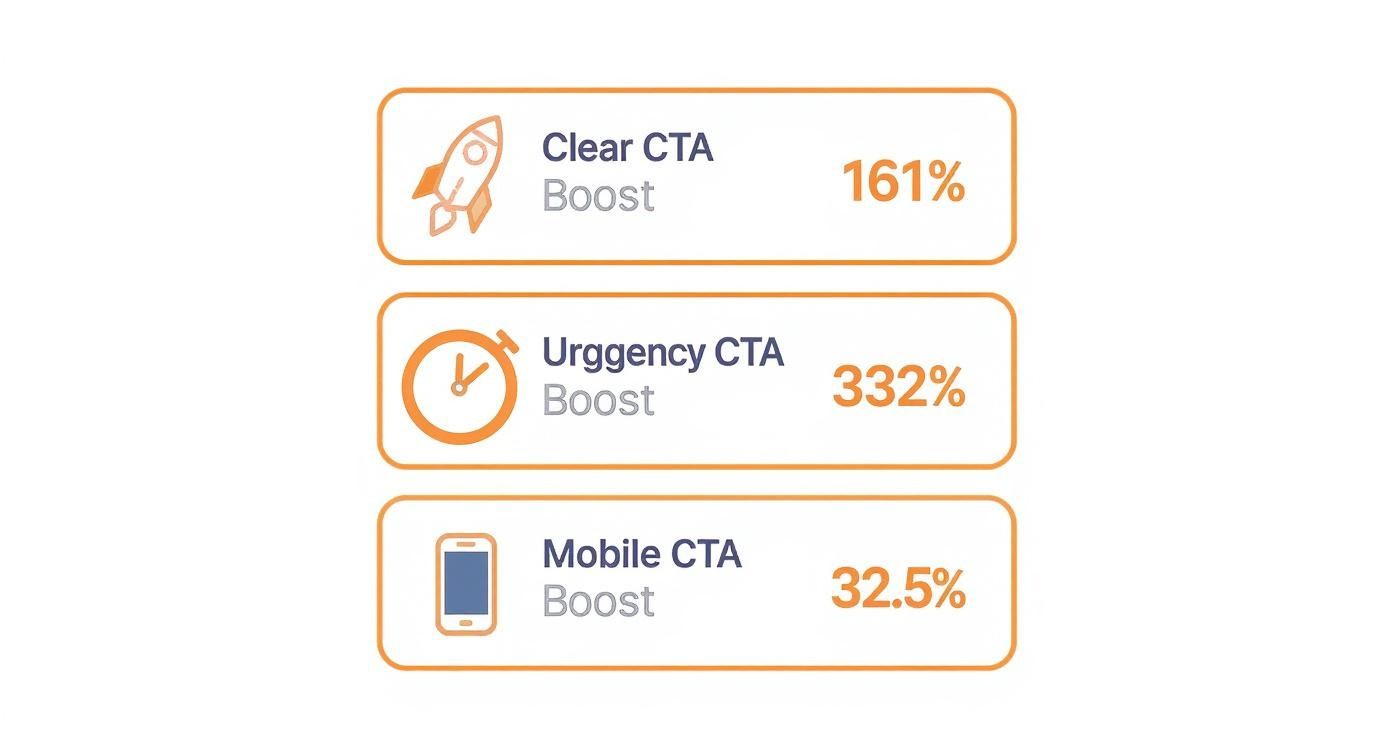
As you can see, while being clear is key, creating a sense of urgency can really supercharge your conversion rates.
Optimize Your CTA Design for Clicks
Your words can be perfect, but if the CTA button is buried or hard to see, no one will click it. The design is just as important as the copy. Your CTA needs to stand out visually, be easy to spot, and look clickable. Things like color, size, and placement all play a huge role. To get a better handle on how to test these changes, you can explore a creative testing framework to figure out which designs work best.
The numbers don't lie. Small design changes can lead to huge wins. A clear, well-worded CTA can boost conversions by an average of 161%. Simply making the button bigger can increase clicks by 90%, and making it mobile-friendly can improve conversions by 32.5%. But the real showstopper? Adding urgency cues like countdown timers can increase conversions by up to 332% by triggering that powerful FOMO response.
How Personalization Improves CTA Results
A generic call to action is like shouting into a crowded room. Sure, you might get a few heads to turn, but you aren't really speaking to anyone. A personalized CTA, on the other hand, is like pulling someone aside for a quiet, one-on-one conversation. It uses what you already know about a visitor to craft a prompt that feels like it was made just for them.This simple shift changes your CTA from a blunt instruction into a helpful, relevant next step. When a visitor feels like you "get" them, they're far more likely to trust your brand and take the action you’re suggesting. You're moving away from a one-size-fits-all approach and toward building a genuine connection.
Tailoring the Message to the User
Personalization can be as simple as using a subscriber's name in an email. A button that says "Jane, Get Your Report" just hits differently than a generic "Download Now." That small touch makes the entire interaction feel more human.
But it can go so much deeper. The real power comes from using dynamic CTAs—prompts that actually change based on a visitor's behavior, their location, or even where they are in your sales funnel.
A dynamic call to action adapts in real-time to the visitor. It’s the difference between a static billboard and a helpful guide who knows exactly where you need to go next.
This level of customization means your message is always relevant. A first-time visitor might see a CTA to "Explore Our Features," while a returning customer might be prompted to "Upgrade to Pro." By meeting people where they are, you make the next step feel completely natural and logical.
The Proven Impact of Personalized CTAs
The numbers don't lie. Personalized Calls to Action have been shown to outperform generic ones by an incredible 202%. That massive lift happens because a message tailored to someone's specific interests, past behaviors, or demographic details just connects on a different level.
Even simple segmenting helps. CTAs customized for a specific industry or buyer can boost leads by around 42%. You can dive deeper into these numbers by checking out these high-converting CTA statistics.
Here are a few ways personalization gets such great results:
- Behavioral Targeting: This shows a CTA based on the pages a user has visited or the content they've downloaded. For example, if someone just finished reading your blog post on video marketing, you could show them a CTA for a webinar on that exact topic.
- Demographic Customization: Here, you adjust the language or offer based on a user's location, industry, or job title. A special offer for a business in New York might look different than one for a startup in London.
- Lifecycle Stage Adaptation: This is all about showing different CTAs to new leads versus loyal customers. A new lead might get a free trial offer, while a long-time customer could see an exclusive "Join Our VIP Program" button.
Ultimately, personalization isn't just a clever tactic; it's a strategy for building trust. When you show your audience that you understand their needs and aren't just shouting at them, they're much more willing to listen to your call to action and take that next step with your brand.
Measuring CTA Success
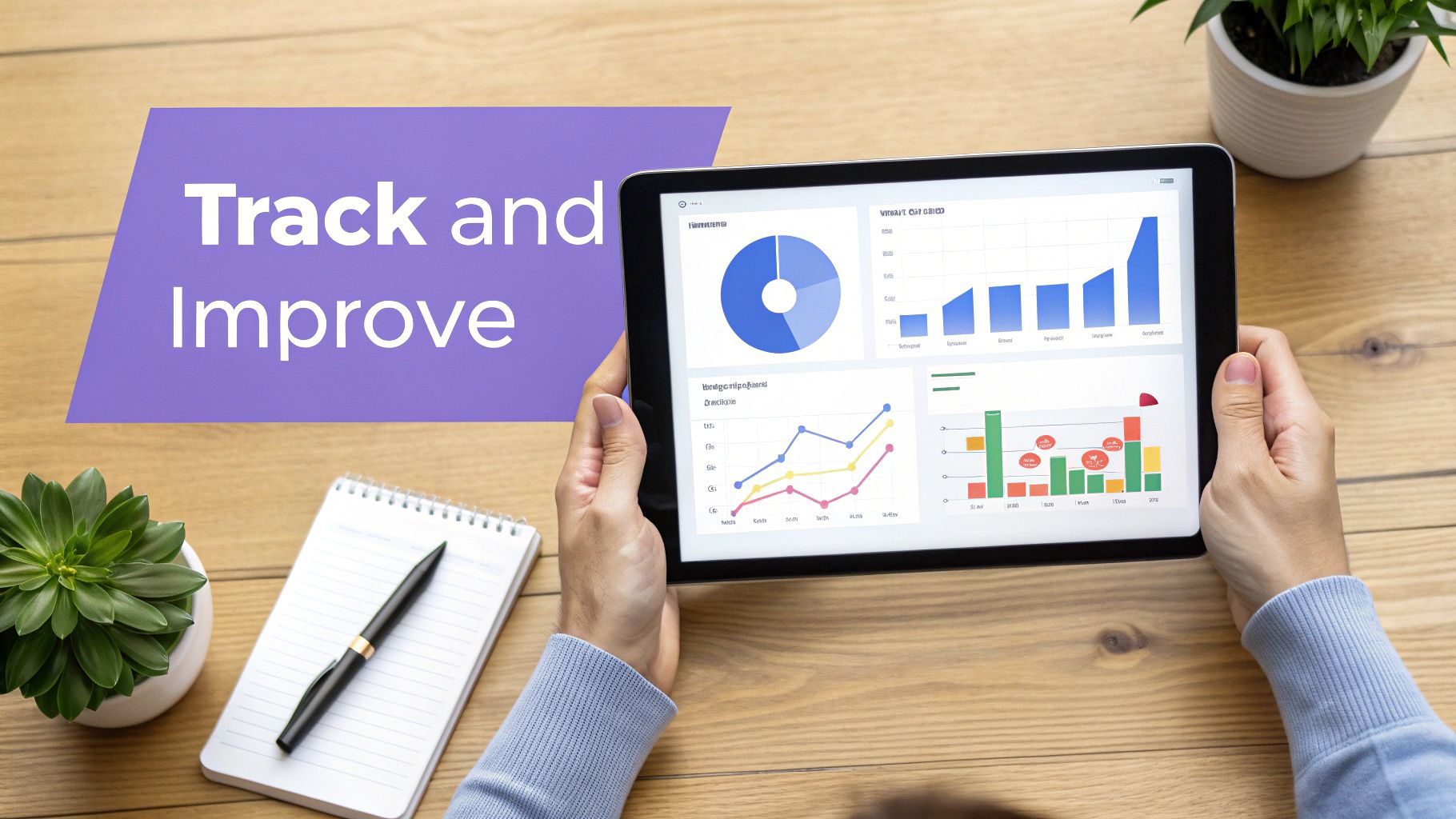
Crafting a great call to action is a huge step, but it’s only half the job. The real question is: is it actually working? If you aren't measuring its performance, you're just flying blind. Tracking the right numbers is how you stop guessing and start making smart decisions that lead to real growth.
Think of it this way—the metrics tell the story of how your audience is responding. They show you what’s hitting the mark and what’s falling flat.
Key Metrics to Track
The first and most direct metric is your click-through rate (CTR). Simply put, this is the percentage of people who saw your CTA and clicked on it. It’s a straightforward calculation: divide the total clicks by the total views (impressions). A high CTR is a great sign that your CTA is compelling enough to grab someone's attention.
But clicks are just the beginning. The conversion rate is where the rubber meets the road. This measures how many of those clickers actually followed through and completed the action you wanted—whether that was buying a product, signing up, or downloading a guide. This is the metric that tells you if your CTA is actually driving business goals.
Tools like Google Analytics are your best friend here. You can set up specific goals to track these actions, giving you a clear window into how each CTA is performing.
Using A/B Testing to Improve Performance
Once you have a baseline, it's time to start improving. The single best way to do this is with A/B testing (or split testing). The concept is simple: you create two slightly different versions of your CTA and show them to different segments of your audience to see which one gets better results.
The golden rule of A/B testing is to change only one thing at a time. If you change the color and the text, you'll never know which element made the difference.
Here are a few classic elements to test:
- Wording: Does "Get Started Today" work better than "Start Your Free Trial"?
- Color: Test a green button against an orange one.
- Placement: See if a CTA performs better at the top of the page versus the bottom.
By running these little experiments, you let your audience vote with their clicks. It’s a data-backed approach that takes the guesswork out of optimization. For a deeper dive, our guide on conversion rate optimization is a great next step.
Turning Insights into Action
Measuring your CTAs isn't a one-and-done task; it's a continuous cycle of testing, learning, and tweaking. The data you collect is pure gold. For example, benchmarks show the average website conversion rate hovers around 2.9%. But a small lift from 2.5% to 3.0% can boost sales by a massive 20%—all without needing a single extra visitor. These impactful CRO statistics really show how small changes add up.
Never stop testing. Your audience’s preferences can change over time, and what worked six months ago might not be the most effective approach today. Continuous measurement is the key to sustained growth.
Every test teaches you something valuable about what makes your audience tick. Pay attention to the numbers, and you can systematically improve every call to action, making sure your marketing is always getting sharper and driving better results.
Your Top Questions About CTAs, Answered
You've got questions, and we've got answers. Getting your call to action right can feel like a guessing game, but it doesn't have to be. Let's tackle some of the most common questions we hear so you can skip the trial-and-error and start getting results.
The Most Common CTA Questions
What are the best words to use in a CTA?
Think clear, direct, and action-oriented. Verbs like “Get”, “Join”, or “Download” are powerful starting points. Pair them with a specific benefit to tell people exactly what’s in it for them. Think "Get My Free Guide" instead of just "Submit."
How many CTAs should I put on one page?
Less is almost always more. Stick to a single, primary CTA that’s impossible to miss. If you need others, make them secondary—less prominent—to avoid confusing your visitors with too many choices.
What's the ideal length for a CTA button?
Keep it short and sweet. The sweet spot is usually between 2 and 5 words. Anything longer can be hard to read at a glance, and you want your message to hit home instantly.
How often should I change my CTAs?
You don't need to change them constantly, but you should definitely keep an eye on them. Check your performance metrics at least once a month. If a CTA isn't performing, it's time for a refresh.
Testing and Placement: The Secret Sauce
Knowing what to say is half the battle; knowing where to say it is the other half. Where you place your CTA can make or break its effectiveness.
Where is the best place for a CTA?
High-visibility spots are your best bet. Think about the end of a blog post (after you've delivered value), right next to a compelling image, or within the body of an email. But remember, every audience is different—the only way to know for sure is to test.
How can I test my CTAs to see what works?
A/B testing is your best friend here. It sounds technical, but it’s simple: you’re just comparing one version against another to see which one wins.
- Create two versions of your CTA, but change only one thing (e.g., the button color, the text, or its location).
- Show each version to half of your audience at the same time.
- Jump into your analytics to see which one got more clicks. The winner stays, and you can test a new variation against it.
At-a-Glance: CTA Placement Impact
Where you put your button matters. Here’s a quick breakdown of how different placements tend to perform.
| Placement | Why It Works |
|---|---|
| Above the Fold | Captures attention immediately, seen by 73% of visitors. |
| End of an Article | Catches readers when they're most engaged and ready for the next step. |
| Sidebar | Stays visible as users scroll, acting as a constant reminder. |
| Email Body | Delivers a highly relevant, contextual prompt right to their inbox. |
"A systematic test can boost click-through rates by over 20%, revealing which CTA resonates best."
Don't just guess what your audience wants. Testing takes the guesswork out of the equation and replaces it with real data, leading to better and better results over time.
Ready to boost your video ad conversions? Try Sprello effortlessly and seamlessly today.
